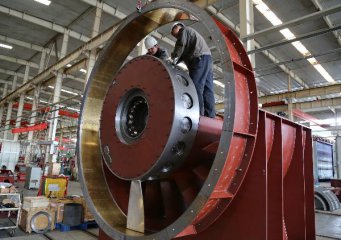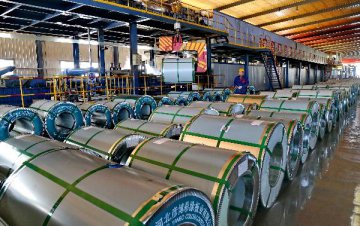BEIJING, April 3 (Xinhua) -- Crude steel production capacity in Hebei province and Tianjin will be capped at 200 million metric tons and 15 million tons by 2020, as China strives to optimize the iron and steel industry, China Daily reported Wednesday.
The Beijing-Tianjin-Hebei region takes up only 2.2 percent of China's territory, but accounts for one fourth of the nation's crude steel output, Lyu Guixin, an inspector with the raw material department of the Ministry of Industry and Information Technology, was quoted as saying by the paper.
The iron and steel capacity of the Beijing-Tianjin-Hebei region was estimated at 280 million tons, although official figures are not available, according to Zeng Jiesheng, chief analyst with steel e-commerce platform Ouyeel.com.
Besides, most of the steel firms in the region still use blast furnaces that are more polluting than electric furnaces, which results in huge energy consumption and pollution discharge burdens, according to Lyu.
To better protect the environment, it is not enough to relocate the production capacity from one place to another within a province as some local governments have done, Lyu was quoted as saying by the paper. Since 2016, China has made remarkable progress in reducing overcapacity in the sector.
The utilization rate of crude steel capacity has risen from 70 percent in 2015 to more than 80 percent now, according to Lyu.
The high profits in the sector last year, which were a result of slashed capacity in the previous years, have prompted the attempts to expand steel capacity illegally, according to Lyu.
Lyu revealed that the authorities will carry out a random inspection on illegal steel production activities this year, through means such as satellite remote sensing, electricity consumption monitoring, and illegal production activity reporting platforms.
China's iron and steel industry reported profits of 470.4 billion yuan (about 70 billion U.S. dollars) in 2018, surging 39.3 percent year on year, while crude steel output grew 6.6 percent to 928.26 million tons, according to the National Development and Reform Commission.
The Beijing-Tianjin-Hebei region takes up only 2.2 percent of China's territory, but accounts for one fourth of the nation's crude steel output, Lyu Guixin, an inspector with the raw material department of the Ministry of Industry and Information Technology, was quoted as saying by the paper.
The iron and steel capacity of the Beijing-Tianjin-Hebei region was estimated at 280 million tons, although official figures are not available, according to Zeng Jiesheng, chief analyst with steel e-commerce platform Ouyeel.com.
Besides, most of the steel firms in the region still use blast furnaces that are more polluting than electric furnaces, which results in huge energy consumption and pollution discharge burdens, according to Lyu.
To better protect the environment, it is not enough to relocate the production capacity from one place to another within a province as some local governments have done, Lyu was quoted as saying by the paper. Since 2016, China has made remarkable progress in reducing overcapacity in the sector.
The utilization rate of crude steel capacity has risen from 70 percent in 2015 to more than 80 percent now, according to Lyu.
The high profits in the sector last year, which were a result of slashed capacity in the previous years, have prompted the attempts to expand steel capacity illegally, according to Lyu.
Lyu revealed that the authorities will carry out a random inspection on illegal steel production activities this year, through means such as satellite remote sensing, electricity consumption monitoring, and illegal production activity reporting platforms.
China's iron and steel industry reported profits of 470.4 billion yuan (about 70 billion U.S. dollars) in 2018, surging 39.3 percent year on year, while crude steel output grew 6.6 percent to 928.26 million tons, according to the National Development and Reform Commission.






















Latest comments